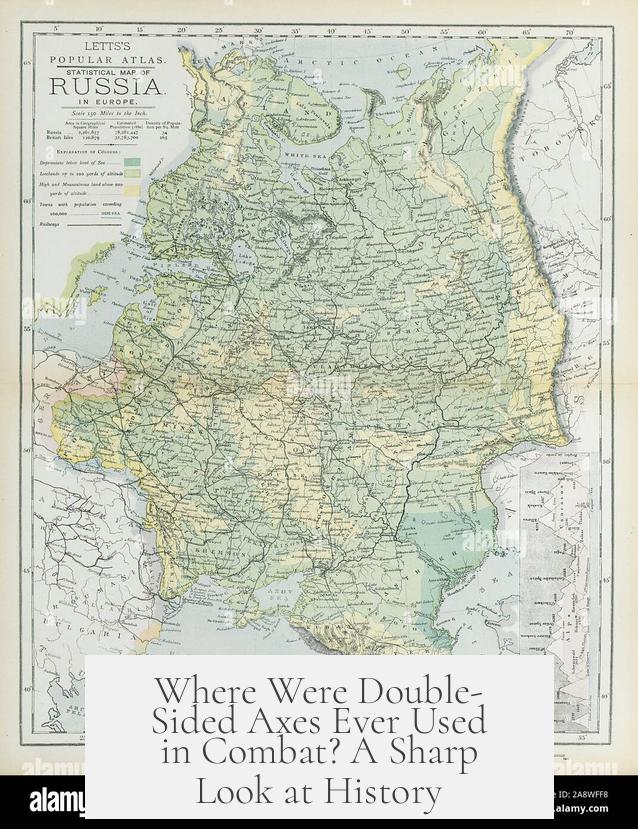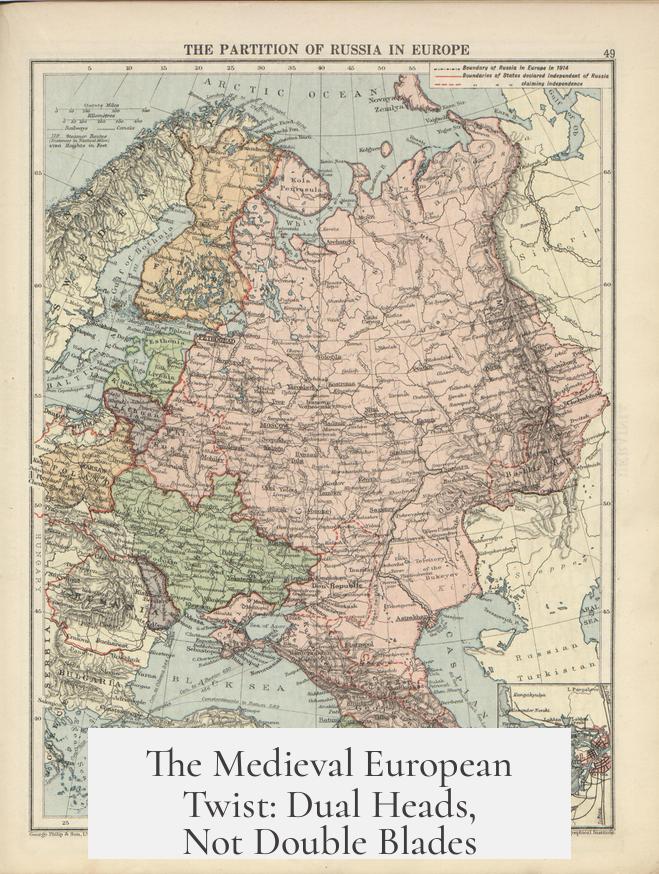Double-sided axes were rarely used as practical weapons in historical combat. Instead, they mainly served symbolic or ritualistic purposes, especially in ancient Bronze Age cultures such as the Minoans and Greeks.
These cultures featured the double-axe, known as the labrys, which carried heavy religious symbolism. It functioned chiefly as a sacrificial instrument rather than a battlefield weapon. The symmetrical double blades emphasized its ceremonial role.
In Northern European contexts, where axes were common weapons, the classical double-axe or bipennis was almost absent. Archaeological records show no finds of such axes in graves or battle depictions. Notably, the Bayeux Tapestry does not illustrate double-bladed axes among Anglo-Saxon warriors.
Some rare double-headed axes have surfaced in archaeological digs but often lacked perfect symmetry. In a few instances, the second blade was set perpendicularly, resembling a combination tool more than a weapon. Experts consider these were likely workman’s implements rather than intended for combat.
Medieval Europe saw a variety of dual-headed weapons, but these generally paired a single axe blade with a hammer, spike, or spear point. This design enhanced versatility by combining chopping with piercing or blunt force. Examples include poleaxes and halberds, which were effective on the battlefield.
In summary, true double-axe weapons with identical blades on both sides rarely appear as combat arms. Instead, multi-headed weapons used in warfare usually had mixed functions rather than two axes. Double-sided axes remain primarily noted for their ritual significance and limited practical use in fighting.
- Ancient double-sided axes mainly served religious roles.
- No strong evidence links symmetrical double-axes to widespread combat use.
- Rare double-headed axes found were likely tools, not weapons.
- Medieval multi-headed weapons combined axes with spikes or hammers, not two blades.
Where Were Double-Sided Axes Ever Used in Combat? A Sharp Look at History

Yes, double-sided axes were rarely used in combat as actual weapons, but their story is far more interesting and complex than you might think. Instead of cleaving enemies with symmetrical blades on both sides, these axes often played bigger roles as symbols, religious tools, or evolved into hybrid weapons combining axe blades with hammers or spikes. Let’s dive into this slice of history and explore where the double-sided axe truly fits.
Imagine you’re walking through the ancient Bronze Age Mediterranean. You see Minoan artifacts adorned with a unique double-axe design called the labrys. Intriguing, right? Yet, this was less about chopping foes and more about invoking spiritual forces.
Double-Axes: The Sacred Symbol, Not the Sword
The double-axe carried heavy symbolic weight in Bronze Age Greek and Minoan cultures. But wait—sacrificial instrument? Yep, you read that right. It wasn’t mainly a weapon.
These societies crafted the labrys as a religious artifact, deeply entwined with ritual sacrifice. It represented power, divinity, and connection to the gods. The double-axe appears on frescoes, shrines, and pottery, but rarely, if ever, on battlefields or in warrior graves. To put it simply: if you found a double-sided axe in those cultures, think shrine, not soldier.
Why does this matter? Because it highlights a crucial point about weapon history. Not every axe is made for war. Sometimes, it’s made for worship or symbolism. The labrys doubles down on that idea. No sharpened edges clashing on the battlefield, just sacred rites and religious awe.
Northern Europe’s Double-Axe — More Myth Than Metal
Now, shift your mental map to Northern Europe, home of fierce warriors and nifty axes. You’d expect double-sided axes to be a staple, right? Not quite.
John Hewitt’s research in Ancient Armour & Weapons points out a surprising absence of the classic double-axe (bipennis) in archaeological digs and medieval art. No double-bladed axes have been found in graves, and they don’t show up in the famous Bayeux Tapestry, which richly depicts Anglo-Saxon weapons.
This suggests the mythical symmetrical double-axe was more uncommon than popular. Instead, single-bladed axes and other weapons commanded the field. The double-axe? More a curious exception than a battlefield standard.
The Odd Double-Headed Tool or Weapon?
Every now and then, archaeologists stumble upon double-headed axes with a twist—literally. Some have blades not on opposite sides, but set at right angles, resembling a hybrid between an axe and an adze (a tool for woodworking).
This arrangement screams “craftsman’s tool,” not “warrior’s choice.” The blunt logic: handling a weapon awkwardly angled like this in combat would be inefficient at best.
So, some double-headed axes were pure practical gear. In short: Not all bladed double tools were weapons, and not all weapons were strictly double-bladed axes.
The Medieval European Twist: Dual Heads, Not Double Blades

Jump ahead to medieval Europe—a period known for its brutal, inventive warfare machines. Here, a double-headed weapon might grip your attention. But hold on, these aren’t your Bronze Age labrys relics.
Medieval warriors wielded polearms and axe-like weapons sporting two or even three heads. But the “second” head wasn’t always an axe blade. Often, it morphed into something else: a hammer for smashing armor, a spike for thrusting, or a combination of the three.
Think of those poleaxes or halberds you’ve seen in museums. They combined a chopping blade with piercing spikes or blunt hammers. Effective? Absolutely. Two axe blades fused back-to-back? That was rare and mostly impractical.
This design shows the innovative evolution from simple chopping tools to complex multi-functional weapons. The dual-head concept survived but took forms far from the clean, symmetrical double-blade.
What Have We Learned? (Besides Wanting to Swing a Double Axe!)
- The iconic double-sided axe was generally symbolic and religious in the Bronze Age Mediterranean, not a battlefield staple.
- In Northern Europe, archaeological and historical evidence doesn’t support widespread combat use of symmetrical double-axes.
- Some double-headed axes found were working tools, shaped for utility rather than battle.
- Medieval European combatants preferred hybrid weapons combining axe blades with hammers or spikes rather than using two axe blades on one weapon.
So, if you ever fantasize about wielding a fierce double-axe in battle, remember: history’s warriors mostly stuck to more practical designs. The legendary double-sided axe shines more in religion, craft, and symbolism than in actual combat.
Final Thoughts: Should We Dismiss the Double-Axe As a Weapon?
Not quite. The double-axe’s rarity in combat highlights interesting cultural shifts and design challenges. Balancing two blades symmetrically introduces handling quirks that practical battle axes avoid. One sharp, well-placed blade trumps two blades clanking together with poor ergonomics.
What if the double-axe had been more practical or easier to wield? Could it have changed the face of ancient warfare? Maybe. But history favors efficiency and effectiveness on the battlefield.
In the end, the double-sided axe remains a fascinating relic of religious rites, artistic expression, and occasional tool use—not your average combat weapon. That’s the story the dusty archaeological records whisper, even if it cuts differently from your expectations.
Were classical double-sided axes used as weapons in ancient combat?
Classical double-sided axes, like the bipennis, were mostly symbolic or used in rituals. Ancient Greek and Minoan cultures valued them for religious reasons rather than for battle.
Did Northern European cultures use double-headed axes in warfare?
There is little evidence that Northern Europeans used symmetrical double-headed axes in combat. Archaeological finds and artwork rarely show these types of weapons in battle.
Were double-sided axes found on battlefields or in warrior graves?
Double-sided axes never appeared in warrior graves or combat scenes in historical records. Their rarity in such contexts suggests they were not common battlefield weapons.
What about medieval European weapons with two heads?
Medieval European weapons sometimes had two heads but usually combined an axe blade with a hammer or spike. True double axe blades were uncommon in combat weapons of this period.
Were any double-headed axes used as tools rather than weapons?
Some rare double-headed axes discovered were likely tools. For example, one had blades set at right angles, resembling an adze or work axe instead of a war weapon.




